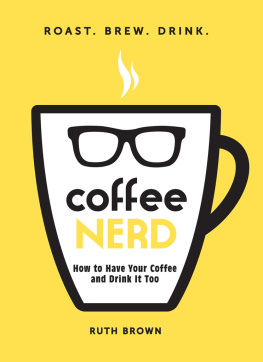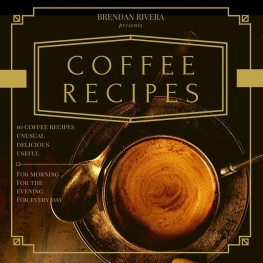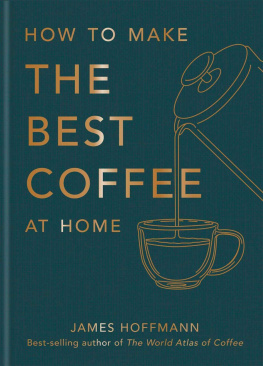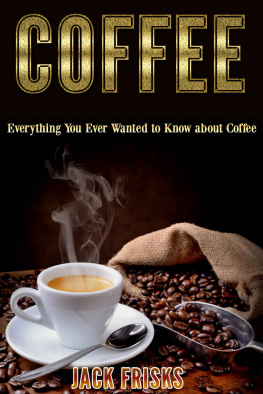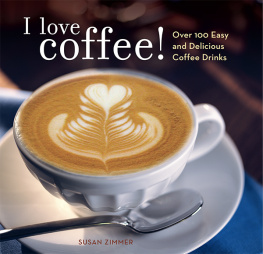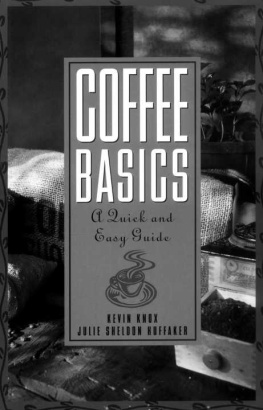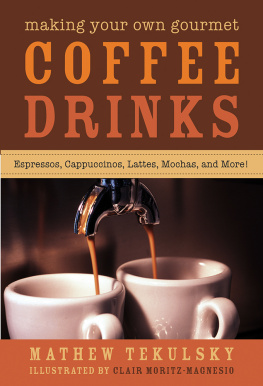Contents
Guide
coffee
NERD
How to Have Your Coffee and Drink It Too
RUTH BROWN

Avon, Massachusetts
Dedication
For James, who prefers Diet Coke.
Contents
Introduction
When did coffee get so cool?
Just a few years ago, it was something that cost seventy-five cents a cup, existed primarily as a study aid, and came in two varietiesregular or black.
Today, drinks cost upwards of $4, take three times as long to make, and are half as big. Coffee houses have gone from cozy nooks with beat-up old couches and cheap muffins to industrial-chic laboratories where all the customers look like eighteenth-century dandies or really wealthy lumberjacks.
Its easy to write it all off as just another hipster fad, like pickling ramps and bar cornhole leagues. But the truth is that the current trends in coffeefrom cheap commodity to totem of coolhave been taking place for decades now, and probably wont be slowing down any time soon. The good news is that most people are just as baffled by the whole thing as you are, so there is still time to get in on the ground floor before all your friends.
Sure, it seems pricey compared to that $1 cup of sludge from your local bodega, but think of it this way: In almost any major city, you can now taste some of the finest coffee in the world, made by top roasters and prepared by award-winning baristas using world-class equipment, without breaking a $10 bill.
And here is the secret: it isnt all that difficult to become an amateur coffee authority. It will cost you far less time and money than your friends who got really into CrossFit or Candy Crush Saga.
How do I know? I am just like you. I am just a regular person who gets out of bed every morning, goes to the office, turns on my computer, goes into the kitchenette and hand-grinds precisely twenty grams of freshly roasted, whole-bean, single-origin coffee and steeps it for four minutes in a full-immersion brewer before going about the rest of my day. I am not a coffee industry professional. I have never been a barista. I learned about coffee by tasting, testing, experimenting and failing, reading, and talking to people. And you can, too.
Once youve nailed it, your newfound knowledge will spill over into other areas of your life, making you an all-around better and more interesting person. Picture this: That impossibly hip lady or gent from the bookstore you hang around pretending to browse literary journals in the hope they will be impressed by your apparent knowledge of contemporary Czech short fiction somehow agrees to go on a date with you. You have a couple of hours, $15.25 (there was a quarter under the couch), and a handful of talking points gleaned from half the courses needed for a film studies degree to impress them with. How do you do it? With the greatest coffee date of their life is how.
You start by taking them to a tiny caf that is so new and unknown it doesnt even have a Yelp page or a cash register yet. You offer to pay, because you know even the most expensive drink is in your budget. Your knowledge of exotic growing regions (Cariamanga, Sulawesi, Gakenkewhere are these places? Dont worry, your date wont know either) will make you sound well-traveled and open up opportunities for casual commentary on current geopolitical issues (Timor-Lestes coffee industry has really improved in quality since the country gained independence from Indonesia...). Your refined palate (Im getting caramel, clove, and a hint of pink gummy bear) suggests you have class and good taste, while your patronage of a local business and friendly repartee with the barista paints you as an engaged citizen and community member.
Most books about coffee are written by industry insiders. This is not one of them. Normal consumers like us neither need nor want to know about the molecular structure of espresso (which is just as well, because I cant explain it)we just want to know what tastes good.
So consider this book the outsiders guide to becoming a coffee geek. From finding a caf to brewing your own drinks, Ive filtered out the bullshit and boiled it down to the stuff you actually need to know to get the most out of your cup and not look like a total moron when ordering at coffee shops.
Because now that coffee is cool, there is no reason you cant be, too.
A long time agobefore I knew anything about coffeeI did work in a bar that had an espresso machine, but the less said about that, the better. Suffice to say, the burns have finally healed, and my apologies to anyone who ever ordered fat-free milkI gave you full cream.
Results not guaranteed.

ONE
Know Your Coffee History
The recorded history of coffee dates back to ancient Ethiopia... Hey! I can see your eyes glazing over from here. Look, I get it. You picked up this book to learn about whats cool in coffee now, so why do we have to talk about long-dead Africans?
Let me put it this way: Imagine trying to learn about punk rock from a fourteen-year-old at the Salt Lake City leg of the Warped Tour. Sure, they can probably give you a pretty thorough rundown of every band currently gracing the front of a Hot Topic T-shirt, but the information will be lacking some fairly important history and context. You need to know about the bands that came before punk.
In fact, to really understand the current goings-on in the coffee world, its important to understand what they arent as much as what they are. Just as punk rock was in part a reaction to the polished commercial rock of the 1970s, todays coffee trends are in many ways a reaction to the polished commercial caf franchises of the 1990s.
On a more serious note: the coffee trade has a pretty horrible history. It has fueledand to some extent continues to fuelslavery, exploitation, poverty, and environmental destruction. When you buy coffee, you become a part of this system. You dont have to care (I mean, you should, you jerk, but you dont have to), but you should at least know what youre not caring about.
So bear with meIll try to make this as painless as possible. (Or if you really dont care, just skip to the next chapter. Its your book; read it however you want.)
Out of Africa
So how about those ancient Ethiopians? The coffee plant is native to the area, so they had probably been eating and cooking its fruits, seeds, and leaves up in various forms since whichever ancient inhabitant was lucky enough to experience the worlds first caffeine buzz and say, Hey guys, youve got to try this. I think itll really catch on!
At some point, another canny citizen must have had the inspired idea to roast the bean-shaped seeds inside the fruit, grind them, and boil them with waterand lo, the coffee drink (kinda) as we (sorta) know it today was born.
Out of Africa (Literally This Time)
The next group to catch the coffee craze were the Arabs, which is no great surprise when you consider that Yemen is just a short trip over the sea from the Horn of Africa. More coffee plants were eventually planted there, and by the sixteenth century, the beans had spread throughout much of the Muslim world. At some point, these guys invented the coffee house, although blueberry scones and poetry slam nights would not appear until many centuries later.

